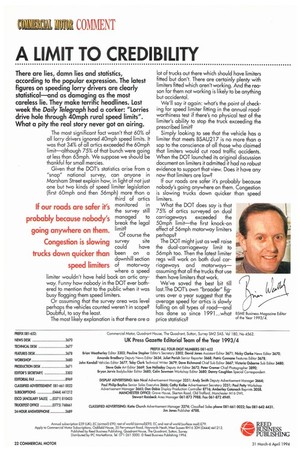A LIMIT TO CREDIBILITY
Page 26

If you've noticed an error in this article please click here to report it so we can fix it.
There are lies, damn lies and statistics, according to the popular expression. The latest figures on speeding lorry drivers are clearly statistical—and as damaging as the most careless lie. They make terrific headlines. Last week the Daily Telegraph had a corker: "Lorries drive hole through 40mph rural speed limits". What a pity the real story never got an airing.
The most significant fact wasn't that 60% of all lorry drivers ignored 40mph speed limits. It was that 34% of all artics exceeded the 60mph limit—although 75% of that bunch were going at less than 65mph. We suppose we should be thankful for small mercies.
Given that the DOT's statistics arise from a "snap" national survey, can anyone in Marsham Street explain how, in light of not just one but two kinds of speed limiter legislation (first 60mph and then 56mph) more than a third of artics monitored in the survey still managed to break the legal limit?
Of course the survey site could have been on a downhill section of motorway where a speed limiter wouldn't have held back an artic an Funny how nobody in the DOT ever Pothered to mention that to the public when it was busy flogging them speed limiters. Or assuming that the survey area was level perhaps the vehicles counted weren't in scope? Doubtful, to say the least. The most likely explanation is that there are a lot of trucks out there which should have limiters fitted but don't. There are certainly plenty with limiters fitted which aren't working. And the reason for them not working is likely to be anything but accidental.
We'll say it again: what's the point of checking for speed limiter fitting in the annual roadworthiness test if there's no physical test of the limiter's ability to stop the truck exceeding the prescribed limit?
Simply looking to see that the vehicle has a limiter that meets BSAU217 is no more than a sop to the conscience of all those who claimed that limiters would cut road traffic accidents. When the DOT launched its original discussion document on limiters it admitted it had no robust evidence to support that view. Does it have any now that limiters are law?
If our roads are safer it's probably because nobody's going anywhere on them. Congestion is slowing trucks down quicker than speed limiters.
What the DOT does say is that 75% of artics surveyed on dual carriageways exceeded the 50mph limit—the first knock-on effect of 56mph motorway limiters perhaps? The DOT might just as well raise the dual-carriageway limit to 56mph too. Then the latest limiter regs will work on both dual carriageways and motorways— assuming that all the trucks that use them have limiters that work.
We've saved the best bit till last.The DOT's own "broader" figures over a year suggest that the average speed for artics is slowly falling on all types of road—and has cone so since 1991...what price statistics?






























































































